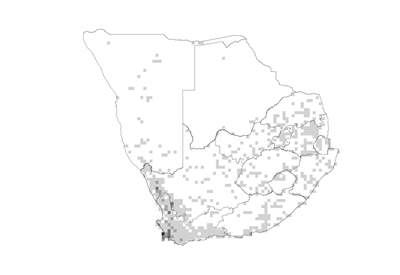 Species distribution and density. Darker squares represent higher density of members of this family. |
Introduction
Oxalis family
The genus Oxalis is the largest in this family (about 500 species) and particularly diverse in southern Africa and South America (Andes region). In southern Africa a single species of Biophytum occurs in the Caprivi Strip (Namibia).
Distribution
Tropical and temperate areas in the world. In southern Africa it has its highest concentrations in the Western and Northern Cape from the Cape Peninsula to Namaqualand.
Number of genera in the world
5
Number of species in the world
ca. 880
Number of genera in the Flora of southern Africa region
2
Number of species in the Flora of southern Africa region
250
Well-known southern African genera
Oxalis, Biophytum
Growth forms
Annual and perennial herbs; mostly geophytes producing rhizomes or bulbs; occasionally succulents.
Habitats
Found on a variety of soil types, most commonly on loam and sand, often in rock crevices or on open flats, in gardens, with a single aquatic species.
Flagship species
Oxalis pes-caprae (Bermuda buttercup; klawersuring [A]) can justly be called 'a pretty harmless pest'. It produces bright yellow flowers, is invasive but does not cause much harm in southern Africa. It reproduces mainly by numerous underground bulbs that easily break from the stems if the plants are pulled out. It is therefore difficult to eradicate and is regarded as a highly invasive noxious weed in the United States, Europe, Israel and Australia. The sour leaves are traditionally used in stews to provide a unique flavour.
Significance of the family
Some species are widely naturalised weeds, e.g. yellow sorrel (*O. corniculata) and pink garden sorrel (*O. latifolia), while a few others are popular garden plants (e.g. O. flava, O. lanata and O. purpurea). The plants contain oxalic acid and when consumed in very high quantities this may cause poisoning in stock and humans. Oca (*O. tuberosa) originated in the Andes of South America and bears tubers similar to potatoes. It is cultivated in cool temperate regions of South America and New Zealand.
Diagnostic characters
Rootstock a scaly bulb . Leaves compound with 3 (rarely up to 10), leaflets . Flowers regular ; petals twisted in bud ; stamens 10 in 2 dissimilar whorls , basally fused; styles 5, free; ovary superior. Fruit a capsule .
Did you know?
The southeast Asian star fruit (*Averrhoa carambola), a popular colourful fruit eaten fresh or in salads, also belongs to this family.